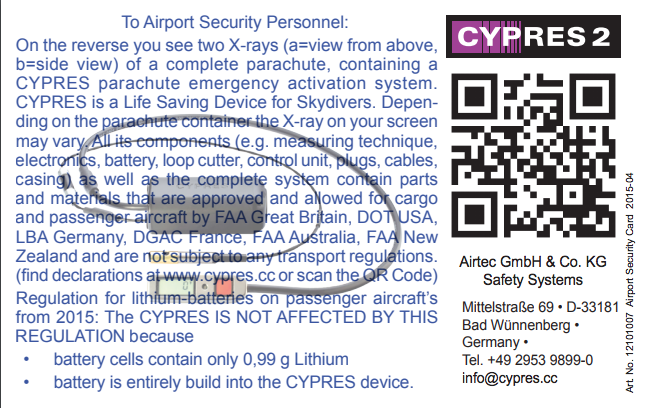Originally published on Dropzone.com in January of 2018.
Getting into skydiving opens up many opportunities for travel. You might live somewhere where the weather is shit all the time, or simply want to take advantage of the beautiful places available to jump around the world. Traveling with your gear can be a worrisome experience. If you are at all sensible, you should already own both a standard travel insurance policy for your belongings and some additional cover that concerns your physical being and any event in which it smooshes into something unforgivingly solid. However, unless you either arrange additional extended insurance (or jump some wonky old contraption built of very dubious elements), the coverage you are paying for is unlikely greater than the value of a set of modern skydiving gear. Your magical backpack is precious to you, and while traveling abroad you will likely feel most inclined to keep your eyes and hands on it at all possible times.

Checked or Carry On?
Once successfully embarked on your career as a skydiver, sooner or later someone will share with you a horror story involving airport security and a parachute. The exact details of this tale are variable, but it will usually involve massive injustice on the part of very ignorant and uncool staff against an innocent and harmless skydiver who just wanted to be perpetually within four feet of their gear by taking it into the aircraft cabin as carry-on luggage – only to be harassed, hassled and sometimes ultimately denied. Situations that escalate this far are rare, but they happen enough among a relatively small community of people to then hang in our collective consciousness as a potential problem – prompting the anxious conundrum of either checking-in one’s rig and thus entertaining the very slim but real possibility of it vanishing forever, or sending it forth through the scanner and risk having to cause a scene because some jobsworth insists on popping your reserve and causing a hundred people in the line behind you to all miss their flights.
What Is This Thing?
What is it about a parachute system that draws the attention of security personnel? It seems logical it would be your AAD that is the most curious element: a mysterious little box complete with a with a couple of protruding wires, a numeric display an activation button (eeek!). In fact, the Cypres unit (the AAD everyone should own) does indeed utilise a very small amount of gunpowder in its design (30 milligrams) – although you should not say this to anyone in charge of aeroplanes. It is up to you to not say this and it is important not to say this. Despite being officially harmless according to all the aviation authorities that matter, try explaining away this nugget of information well enough to be allowed to continue on your journey.
Over many years of traveling as a freefly team, we eventually realised that frequently enough one of us would have to explain how a parachute does (and more importantly – does not) work that we began to rotate who went first through security, therefore being the one to get their rig out and do the explaining. We discovered that it seemed not to matter. Sometimes both the first and second rig would pass unassumingly through the scanner, only for the third to be set aside needing the guided tour – thus leaving the two initial team members on their way into the terminal, chortling at the unlucky third and musing about how mystifying and stupid the process is – as if a single rig is but 33% suspicious and only the cumulative effect of several examples passing by in succession is enough to make the final one stand out as suspect.
Each time an inspection was required we began to quiz airport staff in turn about what they see that makes one’s gear a thing of interest to them. Although as of yet we have received no definitive answers as to exactly why, it appears that the combination of the reserve cable and pilot chute spring that draws attention. A metal cable spiralling into the centre of things just looks unfamiliar enough to be potentially wrong and bad.


What Are The Rules?
As far as all the major aviation authorities are concerned, there is nothing about a complete parachute system that categorises it as forbidden to travel in either the cabin or the hold of any commercial aircraft. Individual airlines might have their own rules for various types of sporting equipment (which you should remember to look up before you go anywhere), but these are much more likely to concern weight allowances and excess baggage fees than any specific security rules.
There are various formal documents available that concern skydiving equipment, but I am yet to meet any airport staff in the world that have actually read them. As such, each transit situation will depend entirely on the personal experience of those charged with viewing your bags – and can range from cow-eyed unconcern (most common), through mild curiosity (sometimes) all the way to haughty indignation that you would dare attempt to take such a thing onto an aeroplane and put everyone’s lives in immediate danger (sucks to be you).
What Happens If You Need To Explain?
Be nice. Always, always, be nice. Airport staff at any step of the way can very quickly ruin not only your travel day – but you whole trip if they feel it is necessary – and smile-kill you while they do so. If you are required to give a presentation, usually a quick explanation while they swab your harness for naughty residues will suffice and you will be on your merry way. If their concern does persist past this point it will probably be because whoever you are talking to is somewhat (possibly very) convinced that your canopy can suddenly and dramatically fully inflate in the cabin, thus freaking everyone the fuck out and covering the windscreen or something. The best course of action here is just keep repeating in a soothing tone “That is impossible” and “It doesn’t work like that” while remembering to be nice. If that doesn’t work you can even have the employee in question deploy your main pilot chute limply onto the floor. Go nuts! Have them pop the pin and send your deployment bag down to join it. Not matter what happens through this interaction try to make it as fun as possible and educate the staff a little bit about your gear and doing your bit for those that come after. You never know – the difference you make here might mean as much as the next person who passes this way meeting their connection or not.

Conclusion
Many people have traveled with their parachutes as carry-on many times, to many places, for many years, with no problems. Every now and then someone just has shitty luck and another tale of woe spreads it’s wings. If things do go badly for you and there is now way out other than to pop your reserve and/or get everything out in exquisite detail, just get it over with. The best play regardless of how far you have to go down this road is always make security personnel feel that they are doing the right thing. Inside you will be seething with rage but if you are a dick to them in even the smallest way nothing good will come of it other than a long conversation in a windowless room. So be nice.
Things To Remember:
1. Put Your Rig In A Bag
You will look super cool wandering around the terminal with your straps all dangling and your G3 clipped to a hip ring like a six-gun. Right up until someone spills sub-standard guacamole all over you.
2. Get Some Paperwork
Airtec produces a nifty credit card thingy that you can whip out to look like a stone-cold professional. It shows an x-ray of a rig that explains why Cypres units are fine for travel and does not mention gunpowder at all. Other AADs are possibly available. For the extra careful there is also a selection of formal documents available in different languages that you can print out and keep in a ring-binder.
